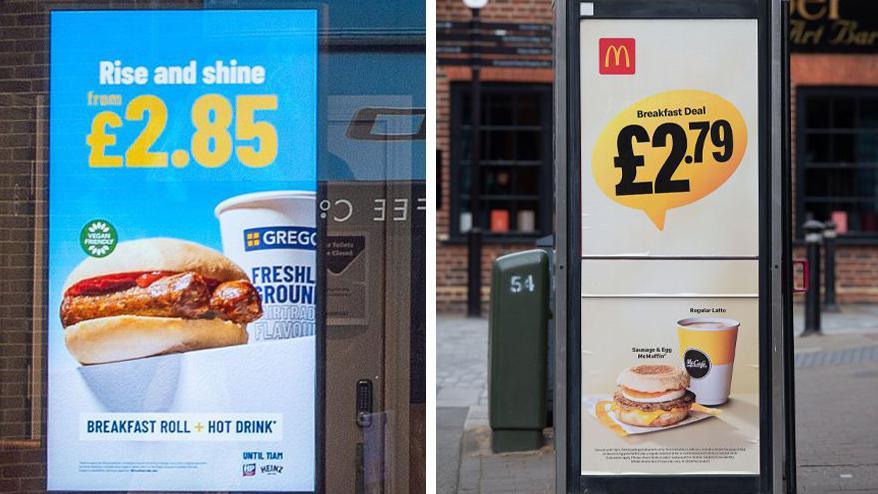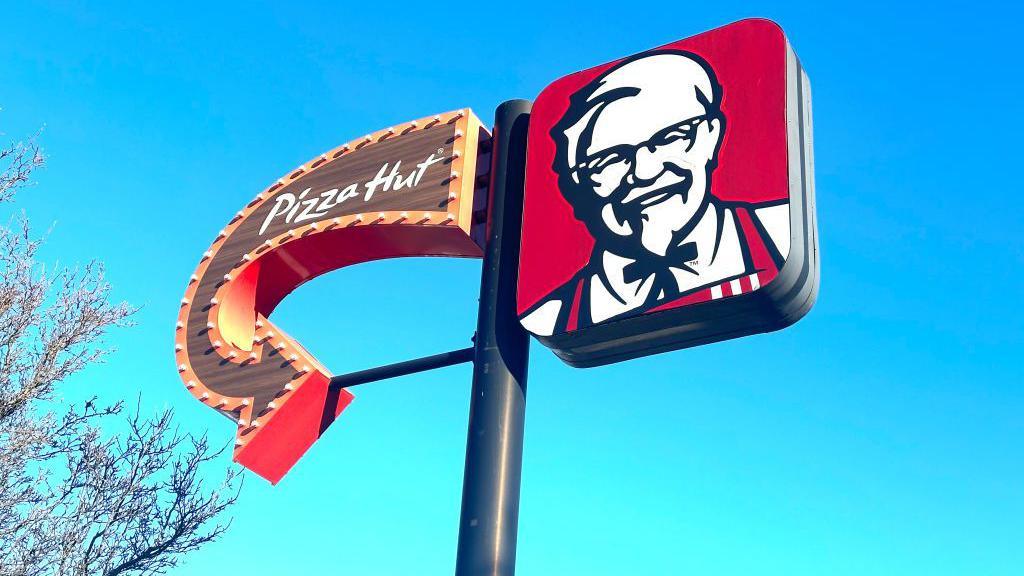Why are there so many fast-food offers on?

- Published
The fast-food giants are falling over themselves in an increasingly competitive race to offer you the best deal.
Whether that’s low-price breakfasts at McDonald’s or at bakery chain Greggs, or lunch offers from KFC and Domino’s, promotions are surging in popularity.
So why the sudden splurge in special offers?
Put simply, customers are being more thrifty and the chains want to tempt you back, though critics worry about the health impacts of this buffet of fast-food deals.
The number of promotions on offer at fast-food restaurants, bakeries and coffee shops between April and June this year jumped by a third from the same period last year.
This is according to data from Meaningful Vision, which tracks the sector.
“The use of promotions is growing as a key tool to generate additional traffic, which has not been growing,” says chief executive Maria Vanifatova.
Footfall was in decline over the year to May, and only now is 1% up on a year ago, she says.
McDonald's to 'rethink' prices after sales fall
- Published30 July 2024
Fast-food operators, like other businesses, put their prices up sharply during the cost-of-living crisis.
But prices in fast food on average increased slightly more than prices in grocery chains, points out Siobhan Gehin, a retail expert at consulting firm Roland Berger, who used to be an executive at KFC.
“This unprecedented speed of change has not really given businesses or consumers time to get used to the new price levels," she says.
This is making customers either trade down to cheaper menu items or eat at home instead, Ms Gehin adds.
As such, fast-food companies are "using the promotion lever to try to stimulate demand".
Pub meal v meal deal
Let’s not forget that firms have a bottom line to think about.
McDonald’s saw its first fall in sales since the pandemic in the second quarter of this year, forcing the company into a "comprehensive rethink" of pricing.
“It used to be quite good value, but is now seen as quite expensive,” says independent retail expert Clare Bailey, whose first job was working in a McDonald’s.
She says you can have a sit-down plated meal in a pub for not much more than a meal deal from a fast-food chain.
But there are reasons the sector has had to put prices up, she says.
High energy costs, packaging costs, the increase in the minimum wage for staff, and in McDonald’s case, the commitment to locally source its beef, have all played a part.

Alistair Macrow, chief executive of McDonald's UK and Ireland, says people face difficult decisions about where and when they spend their money and that value is "more important than ever".
He says the firm listens to customer feedback when it comes to considering what offers to run.
“Our 3 for £3 Deal first ran at the end of the month, when our customers tell us they need help most, and across school half-terms, allowing more families to come together for a meal out.
"We heard it worked, so we have just brought it back to coincide with school summer holidays."
He adds that McDonald's introduced a breakfast deal in the spring - which brought it into direct competition with Greggs - because "customers told us they need to prioritise value at breakfast".
That deal has also been brought back for a limited period.
Maria Vanifatova says lunches have become particularly competitive.
For example, KFC launched a £5.49 lunch deal in March, which gets you a fried chicken wrap, side and drink.
A month later, Domino’s revealed its lunchtime £4 Cheeky Little Pizza, and Pizza Hut and TGI Friday’s have also recently joined the mix.
Marketing tactic
However, while these chains say they are seeking to offer value for money to their customers, Katherine Jenner, director of the Obesity Health Alliance, is cynical and worries about the health impact.
“Multi-buy offers are not designed to save people money - companies are not doing them to be nice," she says.
"They are a marketing tactic designed to get people to buy things they weren't otherwise going to."
Ms Jenner says the portion sizes in fast-food places are much larger than you would make at home. There is also more sugar, salt and fat, she says.
"You can't even make informed decisions about what you’re buying as the information isn’t easily available.”
So how long can we expect this proliferation of promotions to last?
“Once consumers come to expect discounts and vouchers and so on, it’s hard to take it away because a lot of shoppers will come to rely on it," says Ms Bailey.
"They may never have gone there for full price."
Siobhan Gehin isn’t so sure, though.
“I would expect discounting to continue for at least the rest of this year, but to gradually ease off as consumer sentiment continues to improve and as interest rates ease.”
But one trend that looks like it is here to stay is that of offering deals via apps.
McDonald’s Mondays and Burger King’s Whopper Wednesdays are both examples of app-based promotions. KFC and Subway also offer new deals every few weeks for their app customers.
“More and more companies are approaching their loyal clients and offering them deals to keep them loyal,” says Meaningful Vision’s Maria Vanifatova.
They will be hoping that their loyal customers repay them in kind.